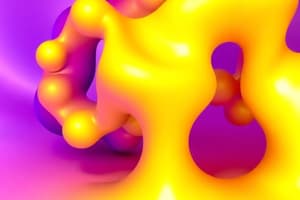Podcast
Questions and Answers
What is the primary goal of PCA?
What is the primary goal of PCA?
- To improve model interpretability by adding features
- To create new data points
- To reduce dimensionality while preserving variance (correct)
- To increase the number of features
Which step comes first in the general application of PCA?
Which step comes first in the general application of PCA?
- Compute the covariance matrix
- Calculate the eigenvectors
- Standardize the data (correct)
- Choose principal components
What does an eigenvector represent in the context of PCA?
What does an eigenvector represent in the context of PCA?
- The mean of the data
- The median of the data
- The amount of variance explained by a principal component
- The direction of the principal component (correct)
What does the eigenvalue associated with a principal component indicate?
What does the eigenvalue associated with a principal component indicate?
In PCA, principal components are:
In PCA, principal components are:
What is the purpose of calculating the covariance matrix in PCA?
What is the purpose of calculating the covariance matrix in PCA?
What is a scree plot used for in PCA?
What is a scree plot used for in PCA?
What does 'dimensionality reduction' mean in the context of PCA?
What does 'dimensionality reduction' mean in the context of PCA?
In PCA, what happens to the total variance of the dataset?
In PCA, what happens to the total variance of the dataset?
After performing PCA, the new variables are called:
After performing PCA, the new variables are called:
Flashcards
BERT
BERT
A pre-trained language model developed by Google, known for its deep understanding of context.
Recurrent Neural Network (RNN)
Recurrent Neural Network (RNN)
A neural network architecture that excels at processing sequences of data, widely used in NLP tasks.
Dimensionality Reduction
Dimensionality Reduction
A technique used to reduce the dimensionality of data while retaining important information.
Deep Neural Network (DNN)
Deep Neural Network (DNN)
Signup and view all the flashcards
Kullback-Leibler Divergence
Kullback-Leibler Divergence
Signup and view all the flashcards
Explainable AI (XAI)
Explainable AI (XAI)
Signup and view all the flashcards
Multi-Task Learning
Multi-Task Learning
Signup and view all the flashcards
Masked Language Modeling
Masked Language Modeling
Signup and view all the flashcards
Token
Token
Signup and view all the flashcards




